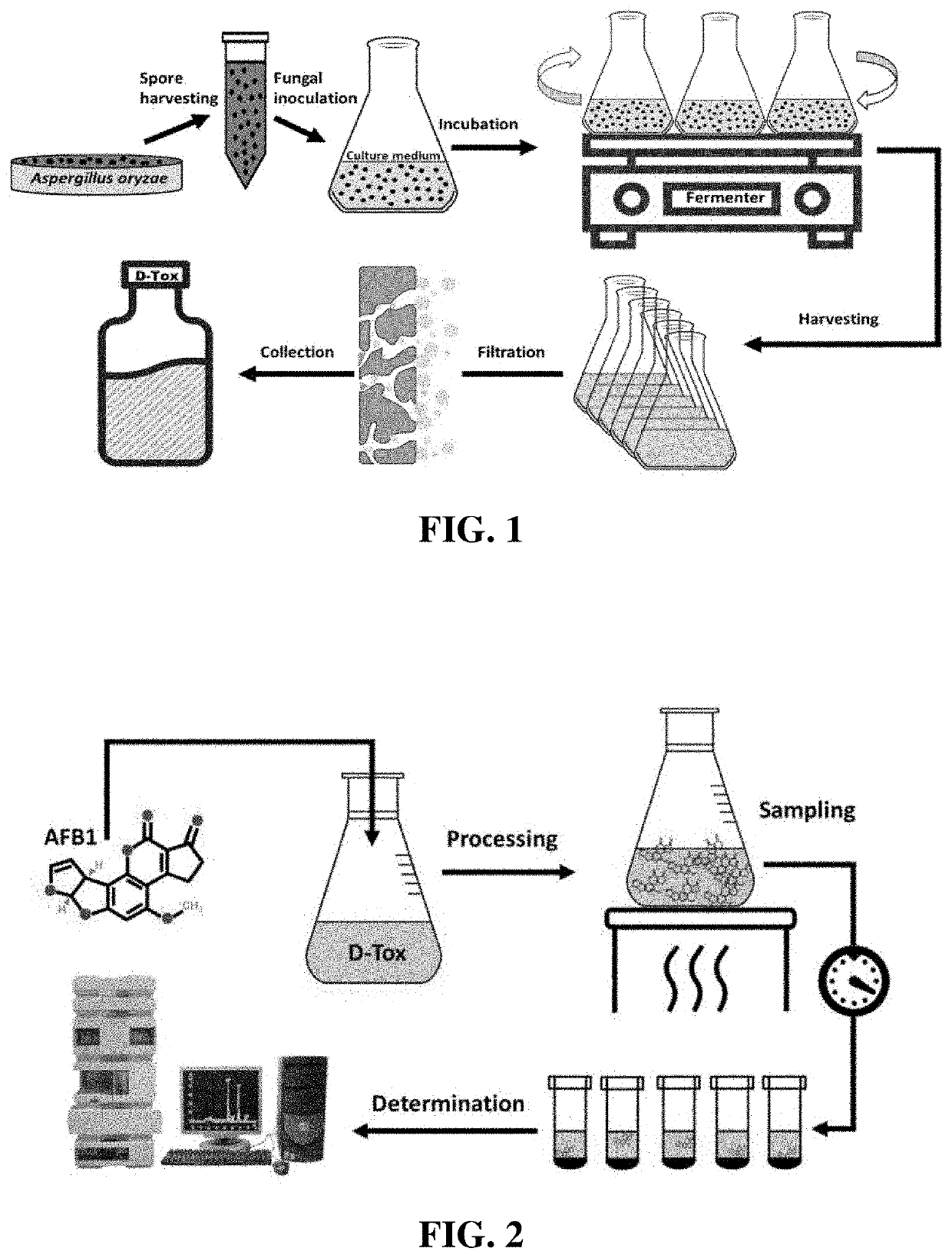Composition for degradation of aflatoxin comprising aspergillus culture filtrate as effective component and uses thereof
- Summary
- Abstract
- Description
- Claims
- Application Information
AI Technical Summary
Benefits of technology
Problems solved by technology
Method used
Image
Examples
example 1
of Aflatoxin-Degrading Activity of D-Tox Depending on Various Reaction Temperature and Time
[0052]The inventors analyzed the degradation level of AFB1 when AFB1 (5,000 ppb) was reacted with D-Tox A (prepared by using Aspergillus oryzae NRRL3483) for 72 hours at 25° C. or 50° C. In addition, the prolonged activity was evaluated when AFB1 (1,500 ppb) was reacted with D-Tox A for 5 days at 30° C. As a result, it was found that the AFB1-degrading activity of D-Tox is proportional to the temperature and time of reaction (FIGS. 3 and 4). It was observed that more than 90% of AFB1 was degraded after 24 hours at the reaction temperature of 50° C., and it was also confirmed that, at the reaction temperature of 25° C., 89% of AFB1 was degraded after 48 hours.
[0053]Furthermore, when D-Tox A is treated with AFB1 (100,000 ppb) followed by heating for 10 minutes, it was shown that 50% of AFB1 was degraded while 96% of AFB1 was degraded after heating for 30 minutes (FIG. 5). On the other hand, AFB1...
example 2
of Aflatoxin-Degrading Activity of D-Tox Derived from Various Strains
[0054]The aflatoxin-degrading activity was compared among various Aspergillus oryzae strains and other Aspergillus strains. As a result, as it is illustrated in FIG. 6, it was confirmed that an excellent aflatoxin-degrading effect is shown from D-Tox which has been prepared by using various Aspergillus oryzae strains or other Aspergillus strains (for example, A. terrus, A. sojae, A. nidulans, A. fumigatus, and A. flavus).
example 3
of Aflatoxin-Degrading Activity of D-Tox Depending on Various pH Conditions
[0055]In order to evaluate the effect of pH on the reaction of degrading aflatoxin by D-Tox, the degradation activity of D-Tox on ABF1 was analyzed by the inventors of the present invention at various pH conditions (pH 6.5, pH 7.5, and pH 8.5). As a result, it was found that, at pH 6.5 conditions, ABF1 was degraded in an amount of 22% and 47%, respectively, when the reaction was carried out for 30 minutes or 60 minutes at 100° C., and at pH 7.5 conditions, ABF1 was degraded in an amount of 60% and 83.7%, respectively, when the reaction was carried out for 30 minutes or 60 minutes at 100° C. Furthermore, at pH 8.5 conditions, ABF1 was degraded in an amount of 66% and 87%, respectively, when the reaction was carried out for 30 minutes or 60 minutes at 100° C. (FIG. 7). Based on these results, it was recognized that the aflatoxin-degrading activity of D-Tox is at least about 3 times more stable at pH 7.5 and pH ...
PUM
 Login to View More
Login to View More Abstract
Description
Claims
Application Information
 Login to View More
Login to View More - R&D
- Intellectual Property
- Life Sciences
- Materials
- Tech Scout
- Unparalleled Data Quality
- Higher Quality Content
- 60% Fewer Hallucinations
Browse by: Latest US Patents, China's latest patents, Technical Efficacy Thesaurus, Application Domain, Technology Topic, Popular Technical Reports.
© 2025 PatSnap. All rights reserved.Legal|Privacy policy|Modern Slavery Act Transparency Statement|Sitemap|About US| Contact US: help@patsnap.com



